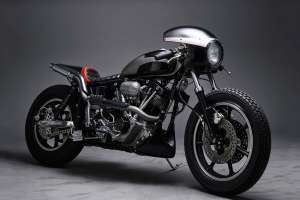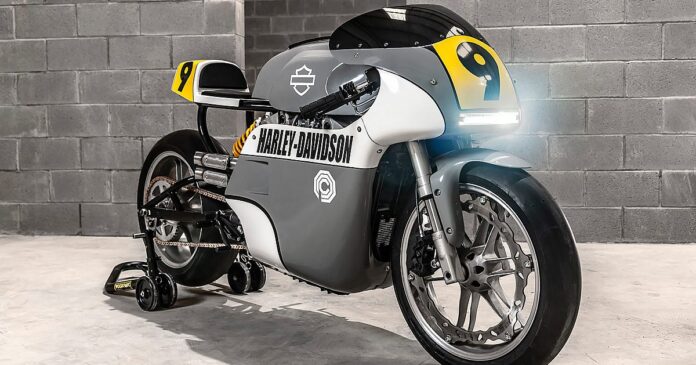Spend enough time around custom workshops, and you start to notice a pattern. Amidst the one-off builds and wild experiments, a handful of familiar silhouettes consistently appear on the lifts. They are the usual suspects—the go-to platforms that builders return to time and again, chosen not for their outright performance or cutting-edge tech, but for their character, proportion, and potential.
While almost any machine can be modified, there are a chosen few that have proven to be the perfect canvas. A great donor bike has good bones: a reliable engine, a simple frame, and a certain intangible quality that inspires a builder to see not what it is, but what it could become. They are versatile, well-supported by a thriving aftermarket, and possess the kind of soul that can’t be engineered on a spreadsheet.
From raw American iron to reliable Japanese twins, these are the platforms that have earned their place in the custom world. Here’s a look at our favorites.
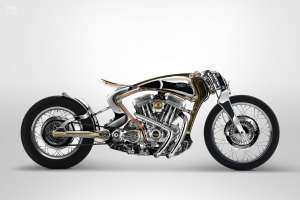
Harley-Davidson Sportster (Pre-2024)
Harley-Davidson’s Sportster line has roots stretching back to 1957, when Harley introduced the XL (‘Sportster’) to compete with lighter, faster British twins. The first Sportsters utilized a 883 cc overhead-valve engine and shared many of the chassis and geometry features of the preceding Model K flathead series. Over the years, the Ironhead versions refined that formula, with riders pushing them on drag strips, flat tracks, and streets alike.
In 1986, Harley replaced the aging Ironhead with the Evolution engine, which used aluminum heads and cylinders for improved heat management and lighter weight. The Evolution Sportster remained remarkably consistent through the decades: the 883 cc and 1,200 cc displacements became the backbone of the line. By 2007, Fuel Injection was added across the line. The final air-cooled Sportsters were discontinued in 2022 (for US markets) and 2020 in Europe due to stringent Euro5 emissions limits, paving the way for the liquid-cooled Revolution Max platforms.
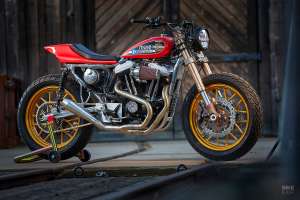
The pre-2024 Sportster’s greatest strength is its incredible versatility. It’s a blank slate, equally at home as a stripped-down chopper, a dirt-flinging tracker, or a lean café racer. Its simple steel frame and iconic 45-degree V-twin are the perfect starting point, and the colossal aftermarket it commands makes almost any vision possible.
Whether you need a weld-on hardtail, a big-bore kit, or a complete pre-made wiring harness, someone makes it. Decades of production mean used examples are affordable and plentiful, providing an accessible entry point for builders looking to wrench on proper American iron.
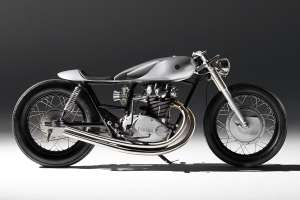
Yamaha XS650
The Yamaha XS650 is often referred to as the ‘British twin done right’—a motorcycle that fused classic aesthetics with Japanese reliability. The engine’s lineage traces back to a German design: Yamaha (via its connection to the Hosk/Showa group) had rights to work from a Horex 500 cc parallel twin design, which they enlarged and modernized. In 1968, Yamaha launched the XS-1 to challenge the dominance of British bikes such as the Triumph Bonneville and BSA twins. Its horizontally split crankcase and single overhead cam layout offered better oil control and fewer leaks.
Throughout the 1970s, the XS650 evolved in small steps. Drum brakes gave way to a front disc. The lineup would split into ‘Standard’ and ‘Special’ variants, with the Special adopting cruiser/factory custom styling (pullback bars, stepped seats, alloy wheels) by the late 70s. Over time, the XS650’s reputation as a stout, tunable twin made it a builder’s favorite.
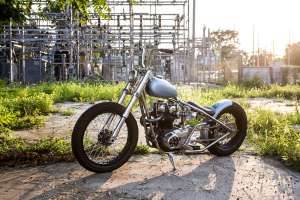
For builders seeking classic parallel-twin style without classic British headaches, the Yamaha XS650 is the undisputed king. It’s the darling of the vintage scene, revered for its nearly bulletproof 653cc engine and perfectly proportioned double-cradle frame. Its enduring popularity means there’s a massive catalog of parts available to transform it into a tracker, café racer, or chopper.
Its simple electronics are a godsend for builders who’d rather spend their time shaping metal than chasing electrical gremlins. Despite all of this, it remains an affordable and approachable platform for creating a truly timeless custom.
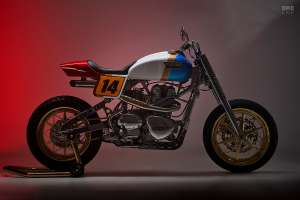
Triumph Bonneville
The Triumph Bonneville carries a storied legacy stretching across British motorcycling’s golden age and the modern retro resurgence. It began in 1959, when Triumph introduced the T120 Bonneville—a high-performance version of the Tiger T110—drawing inspiration from land speed record runs on the Bonneville Salt Flats (where a Triumph-powered streamliner had set records). The original T120 used high-flow Amals, racy cams, and styling that evoked speed and agility. Over the 1960s, the Bonneville became a cultural icon—favored by stars, café racers, and everyday riders alike.
By 1971, Triumph adopted the controversial ‘oil-in-frame’ design, storing engine oil in the frame backbone—a shift that was met with mixed reception. In 1973, the engine was bored out to 750 cc (creating the T140) to remain competitive against Japanese rivals. The Meriden factory survived until 1983, after which the Triumph name passed through licensing and reorganization. In the mid-1980s, Les Harris Engineering built Bonneville derivatives under license, keeping the brand alive while the groundwork for a modern revival was laid.
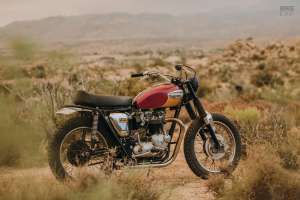
In 2001, Triumph relaunched a clean-sheet modern Bonneville that paid homage to the 1960s style while integrating up-to-date engineering. This modern platform evolved gradually: engines expanded to 865 cc, then, in 2016, Triumph shifted to a liquid-cooled architecture to meet emissions standards. The result: machines that look vintage but ride reliably.
With a pedigree stretching over 60 years, the Bonneville name offers builders two distinct but equally appealing paths. A vintage bike is a direct connection to motorcycling history, serving as the perfect base for a period-correct restoration, a gritty restomod, or a full-blown custom. It’s a chance to work with a true icon. The modern era Bonnevilles, on the other hand, offer a reliable platform with classic looks right out of the box. They are incredibly well-supported by an aftermarket industry dedicated to bolt-on parts, making it easy to create a unique scrambler or café racer with a weekend’s work and a handful of tools.
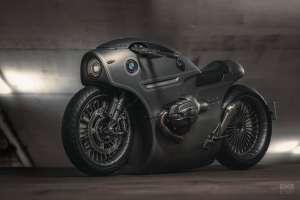
BMW R nineT
BMW’s R nineT is a rare modern motorcycle built from the outset with customization in mind. Introduced in 2014 for BMW’s 90th anniversary, it combined the boxer twin motor with a modular frame and premium parts. The idea was to deliver a neo-retro roadster that also served as a canvas for custom builders. BMW even separated the wiring harnesses (chassis vs engine) and made the rear subframe removable with only a few bolts.
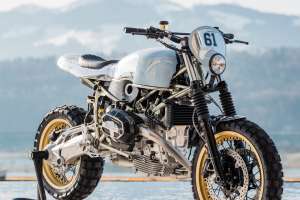
Over time, BMW expanded the R nineT family, each with tweaks to ergonomics, wheels, and suspension. In 2021, to meet Euro5 emissions regulations, the R nineT received revised cylinder heads, upgraded injection, and electronics (ABS Pro, ride modes) while retaining its classic boxer character.
While most bikes on this list became custom favorites by accident, the BMW R nineT was designed for it from the start. It’s a purpose-built platform from a major manufacturer that not only allows customization but actively encourages it. It’s easy to acquire and is supported by several high-end parts suppliers—including BMW’s own Option 719 catalog—that can turn the R nineT into a sleek café racer or a capable tracker without compromising its superb road-holding and track-day potential.
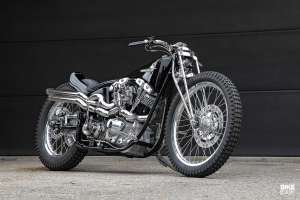
Harley-Davidson Shovelhead
The Harley-Davidson Shovelhead is deeply woven into the mythology of motorcycles. It debuted in 1966, stepping in to replace the Panhead, largely in response to growing weight demands on Harley’s touring machines. The new top end featured redesigned aluminum heads and deeper combustion chambers, and its rocker covers resembled inverted coal shovels—thus the nickname.
Between 1966 and 1969, early ‘generator Shovels’ still ran Harley’s older generator-based electrics and flat timing covers. In 1970, Harley switched to alternator-based electrics and introduced the ‘cone’ gearcase cover—this is the version most associated with the classic Shovel look. The AMF years (1970s) introduced increased production pressures and uneven build quality, which came with reputational and mechanical challenges (oil leaks, vibration). But Shovels captured the essence of a generation.
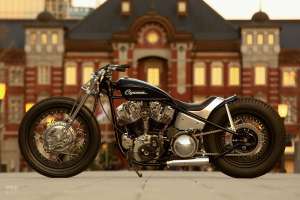
In later years, a larger 80 ci version appeared, giving more displacement to compete with other large-volume import engines. In 1984, the Shovelhead was retired entirely, replaced by the more reliable Evolution engine in Harley’s big twins.
For a builder, it is the quintessential heart of a classic chopper, representing a commitment to an authentic, hands-on riding experience. The Shovelhead occupies the sweet spot for vintage Harley customs; it’s old enough to have legitimate credibility, but new enough that parts are still widely available, making it more accessible than its rarer and pricier Panhead or Knucklehead predecessors. The aftermarket for hardtails, reproduction parts, and performance upgrades is strong, ensuring that this icon of the chopper era remains a favorite for builders who aren’t afraid to get their hands dirty.
